How To Grow Decorative Pepper Plants In Pots
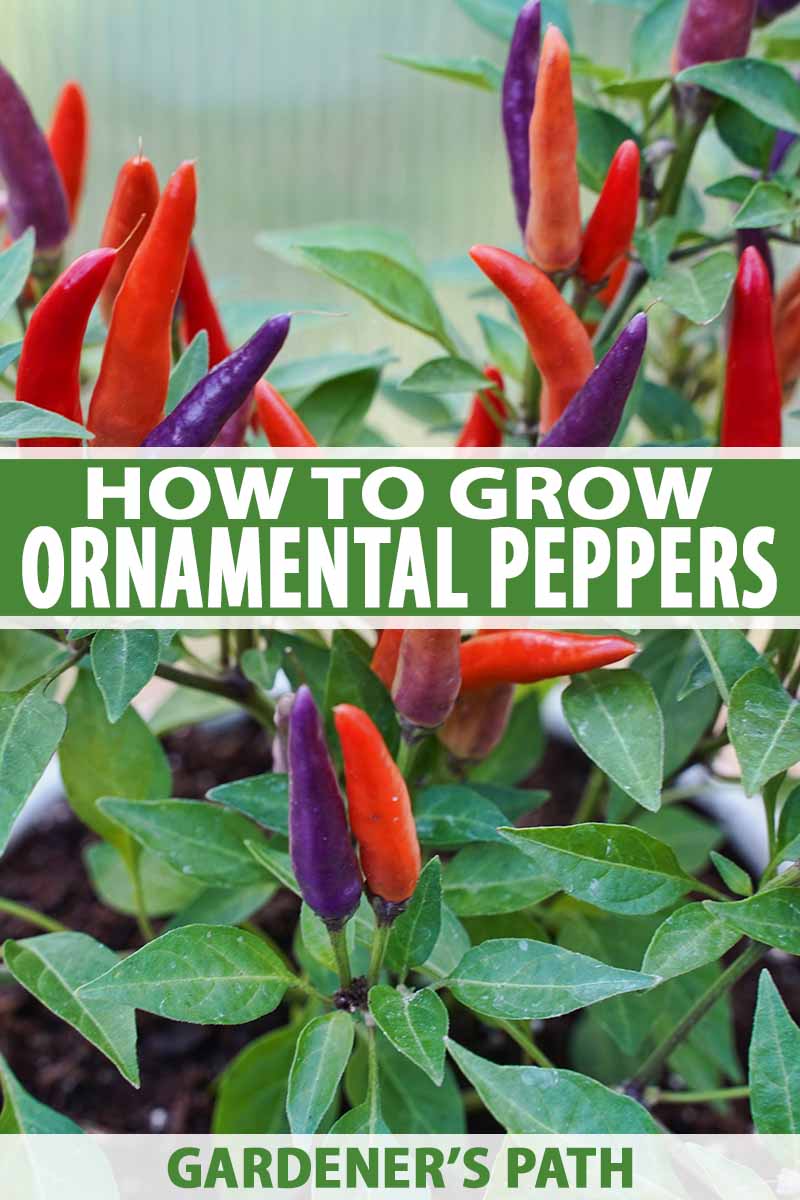
Splashy, colorful ornamental peppers add together dazzling bursts of reddish, purple, yellowish, orangish, black, or white to the garden. And many cultivars display upright fruits that change colour as they mature.
While the species Capsicum annuum includes numerous pepper types that are usually used in the kitchen, such as C. annuum 'Jalapeño,' this article will focus on the varieties and cultivars that are grown mainly as ornamentals – bushy, leafy plants that produce eye-catching clumps of vivid fruits.

Nosotros link to vendors to assistance yous find relevant products. If you lot purchase from one of our links, we may earn a commission .
Ornamental peppers are technically edible, but are non considered particularly tasty. Many are also quite high on the Scoville calibration, meaning they tin can be eye-wateringly spicy. Meet our full guide to growing hot peppers for more information.
Despite having "annum" – Latin for "annual" – in their proper name, these plants are not truthful annuals. They are frost-intolerant perennials, and native to southern N America and northern South America.
In the U.s.a., they are hardy only in Zones 9b through xi. In well-nigh of the country, these plants are grown outdoors as annuals, or grown in containers and brought indoors to overwinter.
These plants produce small flowers – with color that varies by blazon – first in May, followed by peppers that remain on the plant until the starting time frost.
Let's larn more!
What You lot'll Learn
- Propagation
- How to Grow
- Growing Tips
- Pruning and Maintenance
- Cultivars to Select
- Managing Pests and Diseases
- Best Uses
Propagation
Some gardeners have had luck propagating ornamental peppers from cuttings, but this can be tricky.
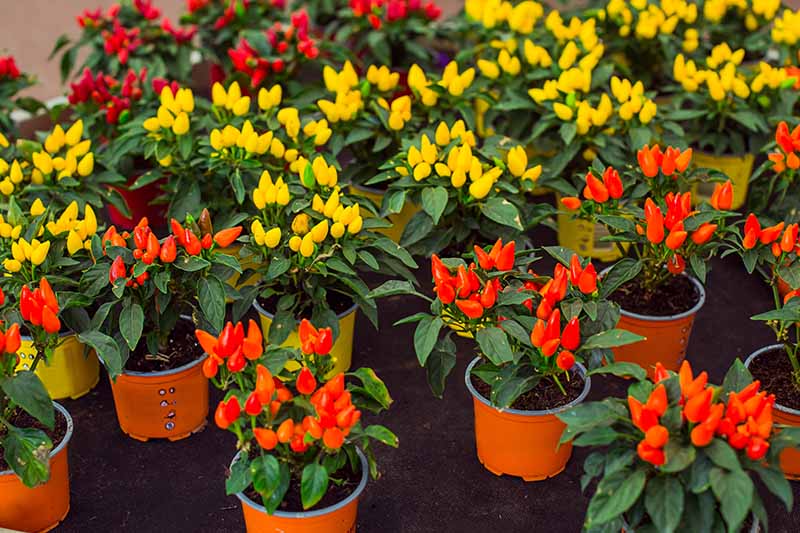
Starting from seed or, better withal, purchasing potted plants or seedlings from a nursery, are the best – and quickest – means to get started.
From Seed
You'll desire to first seeds indoors in a rich potting soil 10 to 12 weeks before your expected last frost engagement. Plant seeds one/8 inch deep and go on the soil moist but non waterlogged.
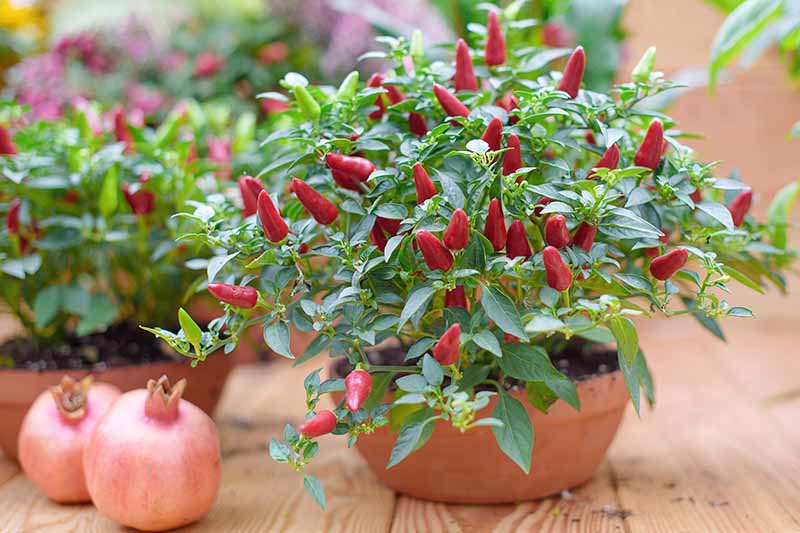
Place the seed trays or pots in a warm identify or on a warming mat set at 75°F. They need temps of 75 to 80°F to germinate, which typically takes near 2 weeks.
Existence tropical plants, chilis similar a lot of calorie-free.
A sunny windowsill can be sufficient, but if there are trees or fences obstructing the light, you lot might desire to consider using abound lights to get them off to a good start.
Position your lights higher up the tiny plants one time the seeds have germinated.

After about eight weeks of growth, they are ready to be transplanted outdoors – provided all risk of frost has passed – or to a larger pot.
From Cuttings
If you want to try your manus at propagating ornamental peppers from cuttings, choose a healthy plant and trim off any dead or dying leaf.
Use a make clean garden knife or sharp pruners to cutting a five-inch-long stalk, making certain that information technology has at least two leaf nodes. These are small swellings on the stem that will eventually sprout new leaves.
Cut on a diagonal to maximize the expanse to allow for greater water absorption, the way you would when trimming flowers in a cutting arrangement.
Strip the leaves from the lesser two to three inches of the cut, and dip it in a powdered rooting medium.
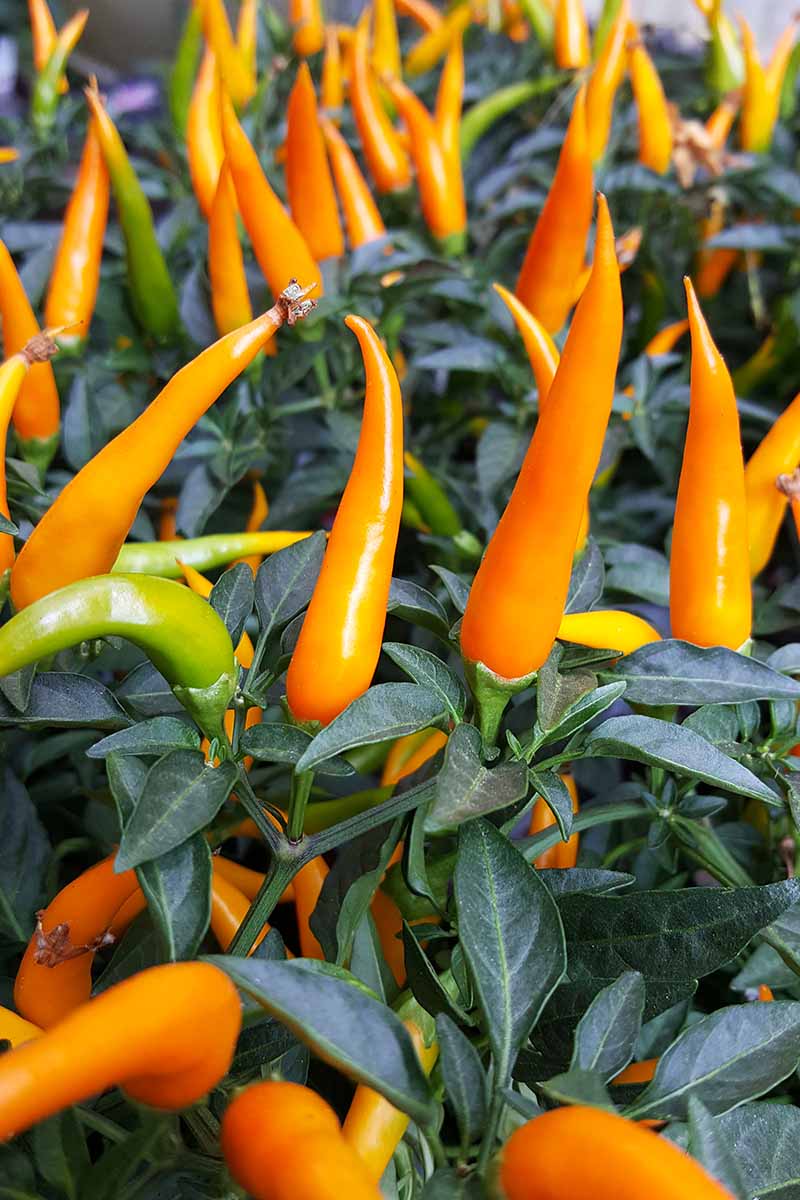
Insert a pencil into a small pot containing well-draining potting soil with drainage holes, and remove it to create a hole for planting. Place the cut into the hole you created.
Water, and identify the cutting in a warm location. Practise not allow the potting medium to dry out out – keep it well watered and moist.
Transplant when your cutting has put on a few inches of growth, afterward about eight weeks.
How to Grow
In one case your cuttings or seedlings are a few inches tall, they'll be ready for transplanting either into containers or into your garden.
But first, remember they've been growing in an indoor environment and will demand to adapt gradually to life outdoors.
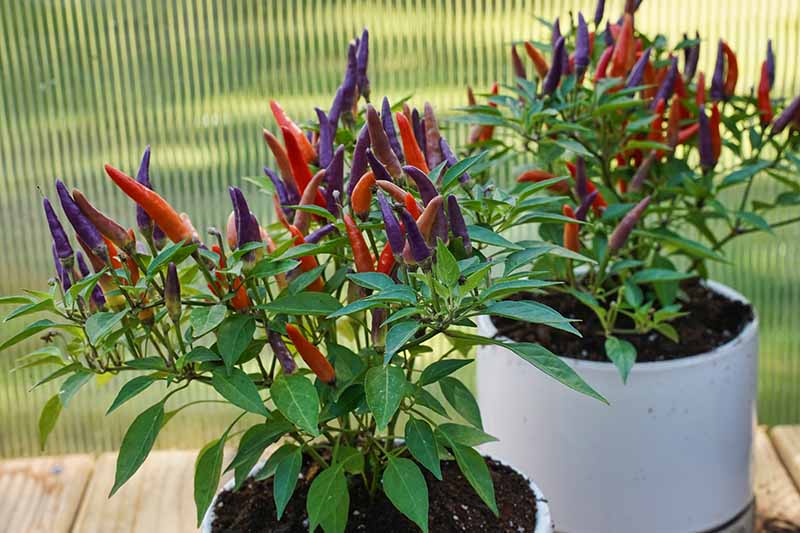
This process is known as "hardening off" and involves putting your young chilis outside for a few hours a 24-hour interval, gradually increasing the fourth dimension that they spend outdoors.
To begin with, identify them in a sheltered spot where they won't be buffeted past the wind.
After a week or 2 of keeping them indoors at night (and during inclement conditions) and outdoors during the day, they should be acclimated to life in the garden.
Ornamental peppers like total sun, but in peculiarly hot parts of the country, they volition tolerate partial shade, too.
If you lot're overwintering your constitute indoors, be sure to place information technology most a sunny window.

These plants prefer a temperature range of 55 to 65°F at night and 70 to 80°F during the day.
They similar well-draining soil that's fairly rich in organic matter. If you're transplanting into containers, identify some drainage textile such as gravel in the bottom of the pot.
The size of the container volition depend on whether information technology'll be one component in a grouping of other ornamentals, or planted on its own.

When you're transplanting or repotting, make sure to keep the root brawl intact to prevent damaging it, and water in well. In the garden, they'll need ane to two inches of water per week.
Water container-grown plants when the meridian half to one inch of soil has completely dried out, and add enough water so that it drains out of the holes in the lesser of the pot.
Fertilize pepper plants with a counterbalanced fertilizer once or twice during the summer.
Growing Tips
- Peppers appreciate fertile, well-draining soil.
- If information technology'due south actually hot out, you lot might need to water plants more often, simply don't allow them to become waterlogged.
- Add mulch within the growing surface area to retain h2o and discourage weeds.
Pruning and Maintenance
You can prune these plants if you want to encourage a more than compact form, just pruning isn't necessary. You tin pinch the growth tips if you want to promote a more bushy plant.
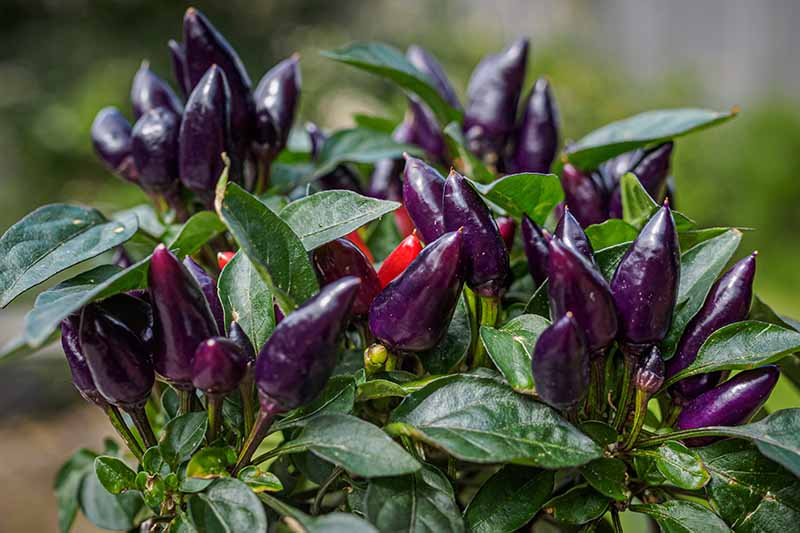
To go along them looking their decorative best, exist certain to remove any dead or dying foliage.
Yous can trim off about a one-half an inch of new growth from the main stalk and side stems when they are about four to six inches long. Don't trim any stems that accept started flowering.
If yous're growing them in a container, you lot'll likely need to repot every couple of years as the plant grows.
Snip off chilis when they start to dry out.
Cultivars to Select
From bright, vivid colors to moody dark hues, at that place are numerous varieties to cull from.
Liven up your patio containers with cheerful reds and purples, or add a black-leafed multifariousness for dissimilarity. Here are a few of my favorite ornamental pepper cultivars:
Black Pearl
This unusual establish produces black leaves when it is grown in directly dominicus.

'Black Pearl '
In young plants and those grown in shady spots, the leaves remain dark green. Growing to around eighteen inches tall, it produces small peppers that start out black and so plow bright red when mature.
Discover packets of 100 'Black Pearl' seeds at Truthful Leaf Market.
Bolivian Rainbow
This heirloom multifariousness grows upwardly to three feet tall and produces big yields of iii-quarter-inch-long peppers that are quite spicy.

'Bolivian Rainbow'
The fruits morph from purple to low-cal yellowish to orange, and so to cherry-red, every bit they mature. The stems and leaves have a purple tint and the flowers are purple.
Grow your ain 'Bolivian Rainbow' plants with these packets of 25 seeds, available via Amazon.
Dank Chili
This type produces two- to two-and-a-half-inch blunt-nosed peppers that cycle through greenish yellow to orange and then to nighttime red.
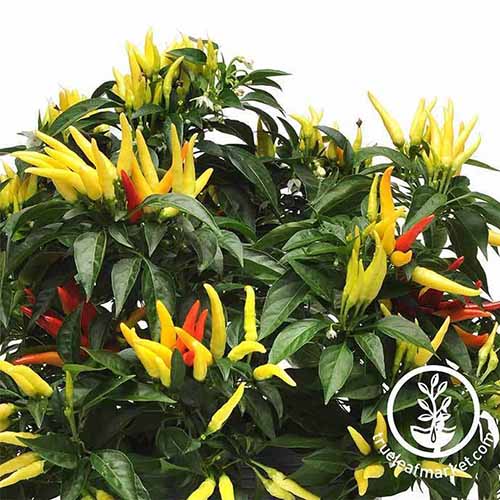
'Chilly Chili'
The meaty plants grow to ix to 10 inches alpine and spread to near xiv inches. Different many ornamentals, 'Chilly Chili' is not spicy.
Go a packet of 100 'Chilly Chili' seeds at True Leaf Market place.
Filius Blue
This attractive variety is an heirloom blazon from United mexican states. It produces 3-quarter-inch spicy, roundish fruit that matures from green to purple-blueish to peach to bright ruddy.
The immature fruit is very spicy, but every bit it matures, the flavor becomes milder. The green leaves are purple-tinged at the edges.
The plant grows from 12 to 18 inches tall and vi to 10 inches wide.
Medusa
The upright, twisty appearance of this constitute's narrow, two- to two-and-a-half-inch fruits is reminiscent of the infamous monster in Greek mythology whose crown sported venomous snakes in place of hair.
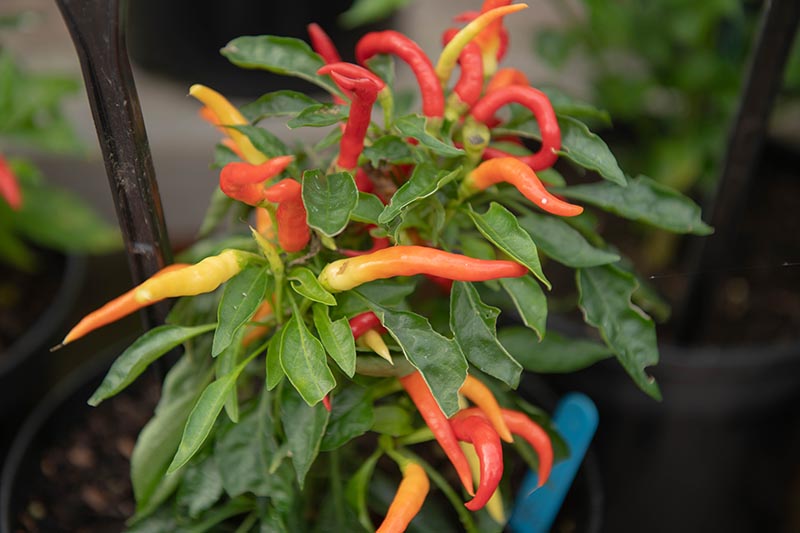
These peppers are more than sweet than spicy, and are borne on compact plants that abound six to 10 inches alpine and nearly equally wide. The fruits mature from ivory white to shades of yellowish and orange before turning bright red.
NuMex Easter
This eight to 10-inch tall plant produces pastel-colored peppers in lavender, foam, stake yellow, and pale orange against a groundwork of dark greenish leaves.
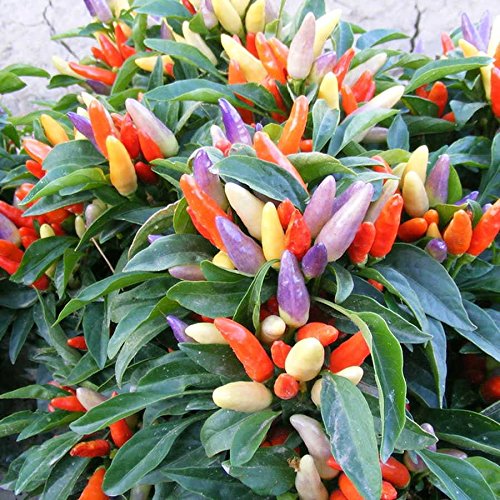
'NuMex Easter'
'NuMex Easter' was an All-America Selections Bedding Plant Winner in 2014, and as such, is particularly useful as a bedding plant.
You tin can order a packet of 10 seeds from Park Seeds via Amazon.
Orangish Wonder
This bright green found grows to about a foot alpine and produces conical orangish peppers in summer and fall, amongst bushy leaf.
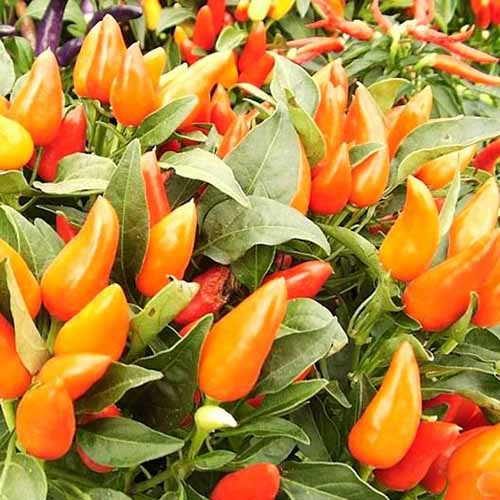
'Orange Wonder '
Find a packet of seeds for 'Orange Wonder' at Eden Brothers.
Sangria
You'll go lots of fruits on this establish, which grows to exist about 12 inches alpine and as wide as 18 inches.
'Sangria'
The two- to three-inch fruits start out imperial, and then alter to orange and finally to carmine.
The chilies produced by 'Sangria' are not spicy, so this plant may be a good selection for households with curious young children who might be tempted to take a bite.
You can find packets of 25 seeds from Seedsown, available via Amazon.
Managing Pests and Illness
Ornamental peppers may fall prey to a few insect pests, besides every bit a couple of diseases.
Insects
A few common bugs tin pester these plants, and insect harm tin be unsightly when you're growing them for decorative purposes.
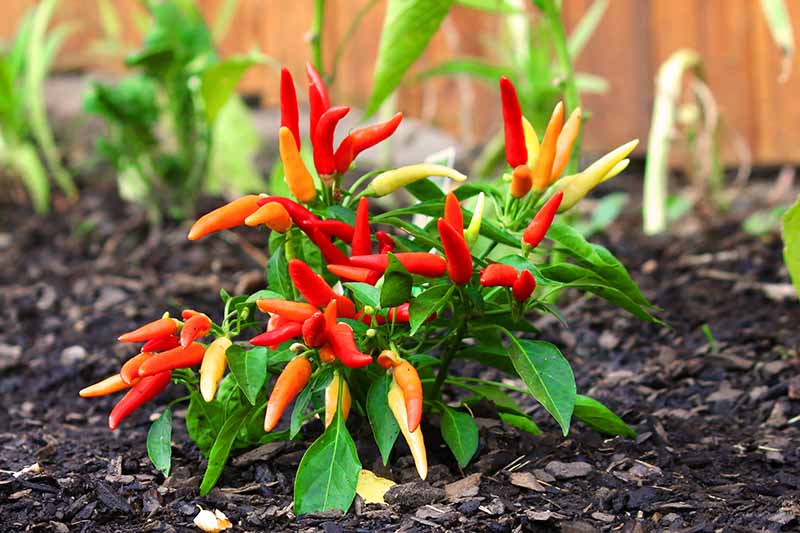
This is usually not much of an upshot indoors, just go on an eye out if your pots are on patios, or in planters by the forepart door.
Aphids
Soft-bodied aphids enjoy sucking fluids from a wide variety of plants, and ornamental peppers are no exception. These modest, pear-shaped insects cause plants to become stunted and plain-featured.
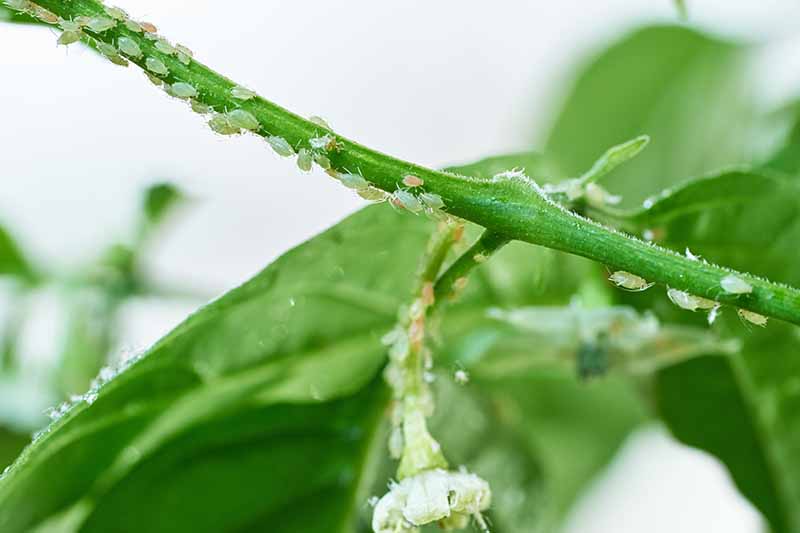
Blast them off with water, or use an insecticidal soap to impale them.
Cutworms
"Cutworm" is a generic name applied to the larvae of a number of moth species.
They are usually brown or gray and ofttimes mottled. They do their impairment past cutting into the base of plant stems. They as well like to champ on roots.
Get rid of these pests by sprinkling diatomaceous world around your plants.
Find more tips on combatting cutworms here.
Pepper Maggots
These pocket-size, white pests are the larvae of a fly that lays its eggs nether the skin of peppers.
The larvae snack on the inside of the peppers, damaging them past stunting their growth. You can usually detect the presence of pepper maggots by the tiny "stings" they leave in the skins of the fruit.
Use viscid traps to catch the adults before they take a chance to lay their eggs.
Whiteflies
These pests are minor white flies that suck out plant juices, causing deformed plants. Control these pests with insecticidal lather or sticky traps.
Read more than about whitefly control here.
Disease
A couple of diseases can plague ornamental pepper plants.
I of the hazards of growing them ornamentally is that you may be inclined to group them closer together than you would your crop plants, inhibiting airflow. Keep your plants looking fresh by removing any damaged or dying fruits and leafage.
Mosaic Virus
Plants infected by mosaic virus will exhibit white, dark-green, or yellowish spots, stripes, or streaks on their foliage. You may also see curled or wrinkled leaves, and the plant'due south growth may be stunted.
This virus can be spread past aphids, so prevent information technology by keeping those pests in check.
Affected plants cannot be cured and must be pulled up and destroyed. Forestall viruses past practicing make clean gardening practices such equally keeping the growing area gratis of weeds and droppings, using clean tools, and keeping pests at bay.
Verticillium Wilt
This disease is acquired by any of six species of fungi that live in the soil and enter a establish via the roots. The affliction manifests in wilted plants, and discolored and curled leaves.
Afflicted plants must be pulled upwards and destroyed. Contaminated soil may exist cured via solarization, a procedure of heating up the soil to kill the fungus.
To do this, clear the soil of plants and debris, then till or dig up the soil. In the hottest office of the summer, wet the soil thoroughly, and cover the area with a clear plastic tarp.
Coffin the edges of the tarp to trap the rut. Go out the plastic in identify for 4 to 6 weeks, and then remove it.
Best Uses
Many gardeners enjoy growing ornamental peppers in containers for their decorative value, both outdoors and indoors.
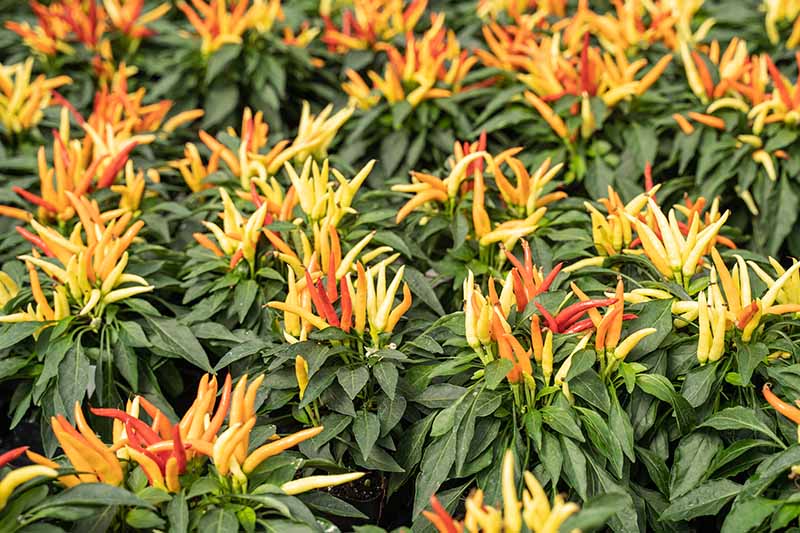
These colorful plants brand attractive specimens in the landscape, and as well await spectacular in mass plantings.
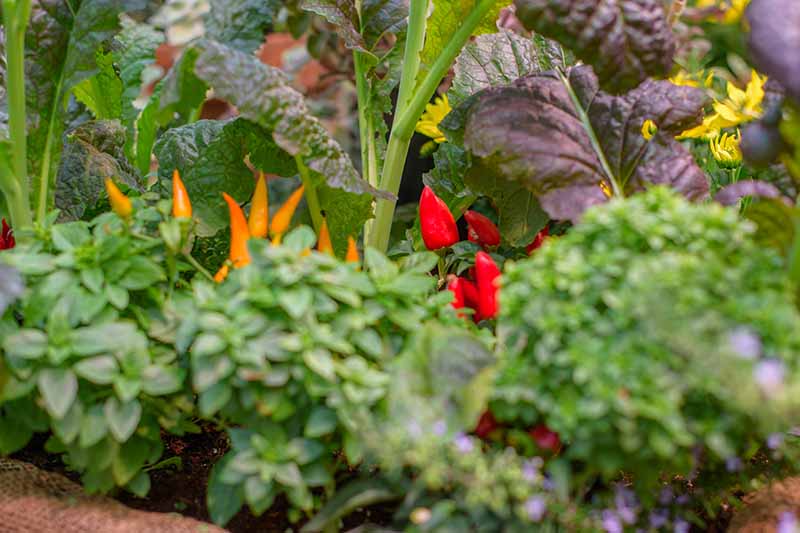
Shorter varieties make a beautiful addition to borders.
Incidentally, small pots of ornamental peppers, wrapped in colorful cellophane and tied with a bow, are frequently given as gifts at Christmastime.
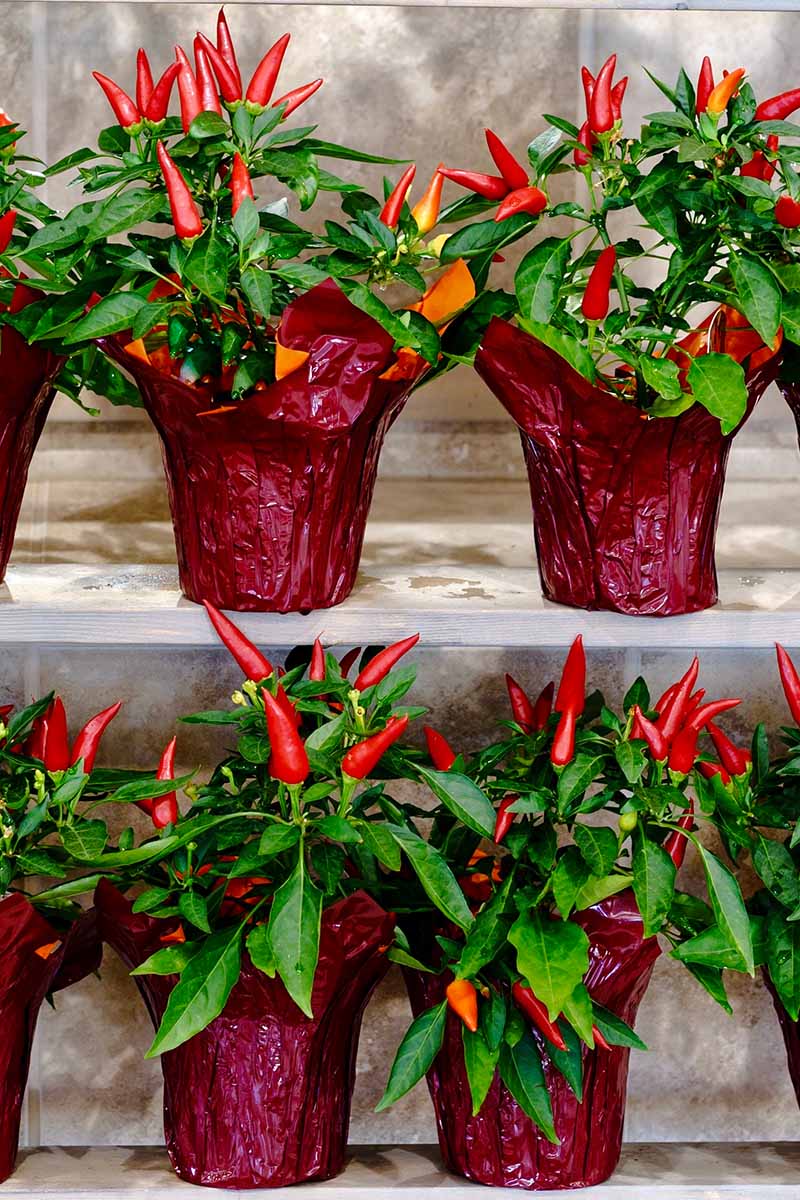
Some folks might know them every bit "Christmas peppers" because of this tradition.
If Not Delicious, Certainly Beautiful
Colorfully attractive and sometimes – merely non e'er – tasty, ornamental peppers add spectacular interest to the mural, or a pop of brilliance to a sunny spot indoors.

And all that beauty comes with relatively fiddling try. They exercise appreciate compost-rich soil and a skilful amount of water, just aside from those requirements, you won't spend a lot of time worrying over these beauties.
Keep an eye out for a few pests, and that'due south almost information technology! You'll relish a brilliant show of colorful fruit for weeks on stop.
Have you grown ornamental peppers? Do you lot abound them in the landscape, or in containers? Share your tips in the comments department below.
What else will you add to your garden? Check out these helpful growing guides next:
- Grow Crunchy, Sweet Bong Peppers In Your Own Lawn
- How to Found and Abound Poblano Peppers
- How to Plant and Grow Ground Cherry, a Tasty Tropical Berry
How To Grow Decorative Pepper Plants In Pots,
Source: https://gardenerspath.com/plants/annuals/grow-ornamental-peppers/
Posted by: bainwinfort.blogspot.com


0 Response to "How To Grow Decorative Pepper Plants In Pots"
Post a Comment